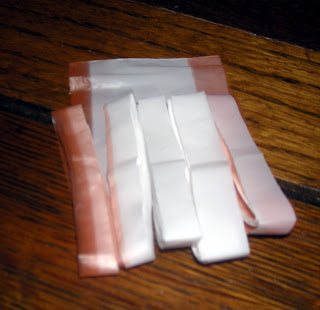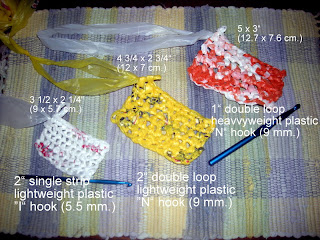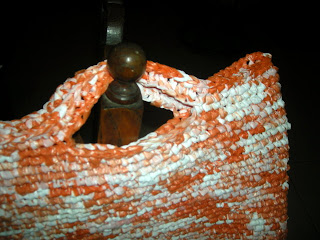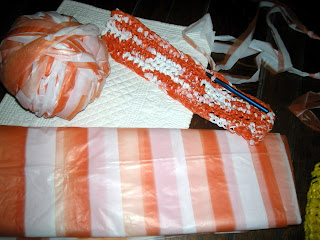Balls of plarn (plastic yarn)
Plarn is a clever name for plastic yarn. Plastic isn't really anything like yarn, but the name incorporates the idea that you will be using it for needlework, as strange as that sounds. Before you start cutting, be sure to read the tips in "Tips for avoiding the plastic torture bag." Most importantly, before cutting up all of your plastic bags, cut just a few first and make a small swatch to see how comfortable it is to work with and whether you are getting the size and thickness that you want for your project.
 So how do you get from this (your stash of plastic bags) to the plarn shown above? Gather up your bags, a pair of scissors, and a ruler or yardstick. Here are step-by-step instructions to cut plarn in three different ways. Click on any of the photos to show them larger in your browser window.Method #1 - Loops with square knotThe first method results in a double thickness of plastic so keep that in mind when determining the width to cut the plastic. I don't recommend this method for heavyweight bags. This method is a little faster to cut and after knotting about 10 bags, you'll become a knotting machine and have them connected in no time.
So how do you get from this (your stash of plastic bags) to the plarn shown above? Gather up your bags, a pair of scissors, and a ruler or yardstick. Here are step-by-step instructions to cut plarn in three different ways. Click on any of the photos to show them larger in your browser window.Method #1 - Loops with square knotThe first method results in a double thickness of plastic so keep that in mind when determining the width to cut the plastic. I don't recommend this method for heavyweight bags. This method is a little faster to cut and after knotting about 10 bags, you'll become a knotting machine and have them connected in no time. Lay down one bag, smooth out the wrinkles and squeeze out the air by running your hand over it from the bottom seam to the top. Fold neatly into thirds.
Lay down one bag, smooth out the wrinkles and squeeze out the air by running your hand over it from the bottom seam to the top. Fold neatly into thirds.
Cut off the bottom seam and the handles, if any. Fold in half or thirds again so that you have a thickness that will be easy to cut. Lay the folded bag against a yardstick and with scissors make snips to mark your desired cutting lines, for example, every inch or two inches (2.5 or 5 cm.). Even quicker is to snip only every other cut. Pick up the folded bag and hold it carefully to finish cutting the strips apart, eyeballing where to make the center cut if you only marked every other cut. The plastic will slide around a little but don't worry if your strips are not all the exact size.
Lay the folded bag against a yardstick and with scissors make snips to mark your desired cutting lines, for example, every inch or two inches (2.5 or 5 cm.). Even quicker is to snip only every other cut. Pick up the folded bag and hold it carefully to finish cutting the strips apart, eyeballing where to make the center cut if you only marked every other cut. The plastic will slide around a little but don't worry if your strips are not all the exact size. You'll end up with a pile of loops like this. If your plastic bags vary slightly in color or opacity, connect them together randomly so that the difference won't be noticeable. If they are significantly different, you could ball them separately for a striped project.
You'll end up with a pile of loops like this. If your plastic bags vary slightly in color or opacity, connect them together randomly so that the difference won't be noticeable. If they are significantly different, you could ball them separately for a striped project.
The loops are connected by making a square knot. No tails to deal with later! Shake out the loops.
 Place the end of loop #1 on top of loop #2. In this photo, I'm calling loop #1 (white and blue) the long piece and loop #2 (yellow) the short or new piece. If you've already joined several pieces or have starting making your ball, this will be loop #1 and it will be your stationary side
Place the end of loop #1 on top of loop #2. In this photo, I'm calling loop #1 (white and blue) the long piece and loop #2 (yellow) the short or new piece. If you've already joined several pieces or have starting making your ball, this will be loop #1 and it will be your stationary side.
 Pull the end of loop #2 up and over loop #1 back toward itself.
Pull the end of loop #2 up and over loop #1 back toward itself.
 Feed the other end of loop #2 through the loop you've just made. Now you see why the "long" piece is stationary. It is much quicker to pull one length through to make the knot than to have to pull a long length of plastic.
Feed the other end of loop #2 through the loop you've just made. Now you see why the "long" piece is stationary. It is much quicker to pull one length through to make the knot than to have to pull a long length of plastic.
 Pull gently and evenly to make the knot. Tip: I found that by keeping my thumb in the loop as I pulled helped to make a neater knot. Pull out your thumb just before you finish the knot.
Pull gently and evenly to make the knot. Tip: I found that by keeping my thumb in the loop as I pulled helped to make a neater knot. Pull out your thumb just before you finish the knot. Leave the knot slightly loose as it may need adjustment later as you crochet. Tighten it just before you crochet that section
Leave the knot slightly loose as it may need adjustment later as you crochet. Tighten it just before you crochet that section.
It may be hard to believe, but the knots are really not noticeable in the end product.
Don't worry. After you do a few of these, it goes really fast.Method #2 - Long Single StripThe second method cleverly results in one long piece without knots or joining but requires a little bit more careful cutting. This method is especially good for heavier weight plastic, like department store bags. You could also crochet together two or even three thin strips of different colors for a tweedy or variegated look, but that would probably only work for the thinner plastic and you might want to cut only 1/2" (1.25 cm) strips. Start preparing the bag in the same manner as above (smoothing and folding) but leave about an inch (2.5 cm.) unfolded at the top. Mark and make your cuts but do not cut into the one-inch area at the top of the folded bag.
Start preparing the bag in the same manner as above (smoothing and folding) but leave about an inch (2.5 cm.) unfolded at the top. Mark and make your cuts but do not cut into the one-inch area at the top of the folded bag.
When you have made all the cuts, shake out the plastic, leaving the cut loops dangling and spread the uncut area over your left hand.
 Make an angled cut from the left cut edge of loop #1 at the bottom of your hand to the right edge of loop #1 at the top of your hand.
Make an angled cut from the left cut edge of loop #1 at the bottom of your hand to the right edge of loop #1 at the top of your hand.
Make the next cut from the left cut edge of loop #2 at the bottom of your hand to the left cut edge of loop #1 at the top of your hand. Continue in this manner until you have one long strip. It's hard to describe but easy to decipher if you look at this photo.
Method #3 - Joined Single StripsThe third method can be really tedious but I liked it when cutting thinner pieces for the trim work as the knots were virtually indiscernible. This method worked well for all weights of plastic and for odd parts of the bag and flat pieces of plastic that wouldn't work using method 1 or 2.  Prepare and cut the plastic as in method #1 above, cutting to the desired width and the longest lengths that you can. Fold over about a half-inch (1.25 cm) of the end of one strip and make a short snip in the center of the fold, being careful not to cut through to the end of the plastic. Do this at each end of each piece.
Prepare and cut the plastic as in method #1 above, cutting to the desired width and the longest lengths that you can. Fold over about a half-inch (1.25 cm) of the end of one strip and make a short snip in the center of the fold, being careful not to cut through to the end of the plastic. Do this at each end of each piece.
 Fold one end of the short strip in half lengthwise and poke it through the snipped hole on the long strip (step #1 in the photo) − like you are threading a needle. Pull it through a couple of inches and then fold the other end of the short strip lengthwise and thread it through the hole at the opposite end of the same strip (step #2 in the photo). Pull the short strip completely through the eye. Carefully push the "knot" down and tighten it only enough so that it won't be bulky (step #3).
Fold one end of the short strip in half lengthwise and poke it through the snipped hole on the long strip (step #1 in the photo) − like you are threading a needle. Pull it through a couple of inches and then fold the other end of the short strip lengthwise and thread it through the hole at the opposite end of the same strip (step #2 in the photo). Pull the short strip completely through the eye. Carefully push the "knot" down and tighten it only enough so that it won't be bulky (step #3).
 Here is a closeup in case you are having trouble following my instructions. The long strip is on the left and the short is on the right.
Here is a closeup in case you are having trouble following my instructions. The long strip is on the left and the short is on the right.
This method makes an almost invisible knot which is good for trim areas or decorations where square knot might be too bulky and a knot with tails would be more noticeable.It can also be used for joining pieces made using method #2 above, but remember that you will have to pull the entire length through the "eye".
After you have a long length of plarn, or as you are connecting the pieces, roll it up into a ball. I like to roll mine in balls of 10 bags so that I have an idea of how many I've used and how many more bags I'll need. This also helps to estimate your bag needs on a future project. The yellow ball in the photo at top was 10 bags and the orange ball was only 5. That should have tipped me off that I was getting into the torture bag.All of these methods can also be used for rag crocheting as well. From the information I've been getting from my readers lately, plastic bags may be becoming extinct in some areas! That's great for the environment and I'm very happy to hear it. I imagine that it will be 50 years before that happens in Honduras, but I'll happily switch to rag crocheting if it does occur in my lifetime.Related articles:Tips for avoiding the plastic torture bagNeed more plastic bags! Must have plastic bags!Sneak preview: The plastic bag bag















































 Welcome to my Blogicito —
Welcome to my Blogicito — 








